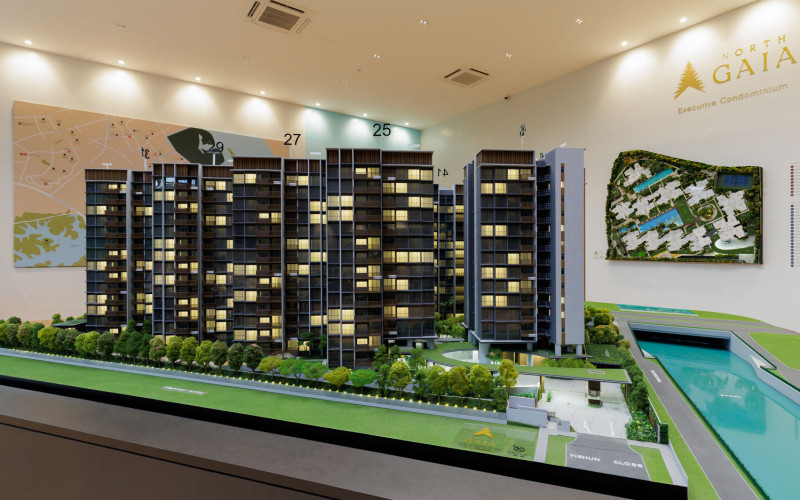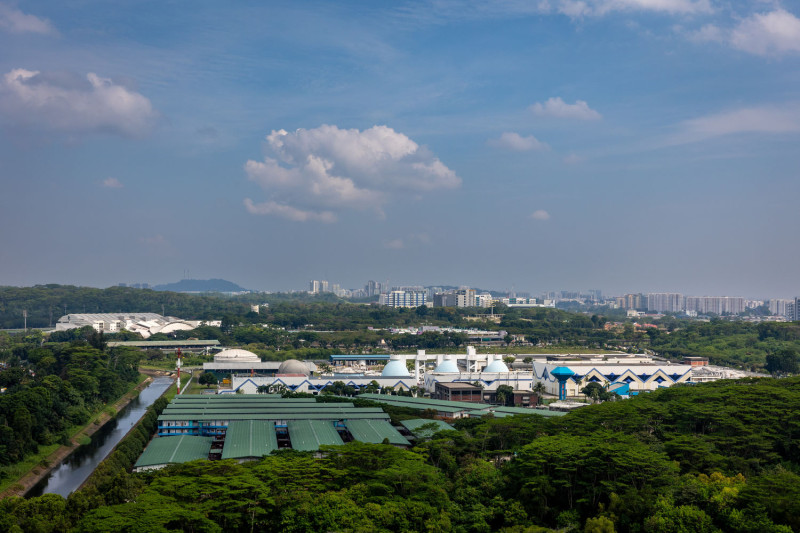North Region’s residential and industrial boom to benefit from enhanced infrastructure
SINGAPORE (EDGEPROP) - At the Committee of Supply debate in March, Minister for National Development Desmond Lee announced plans to meet housing demand with the upcoming Chencharu housing area in Yishun. Fast-forward to June, the estate’s first Build-to-Order (BTO) project, offering 1,277 units, was launched for sale, with more housing projects expected to follow.
The Chencharu estate sits on a 70ha site that formerly served as a colonial plantation house in the 1900s and was subsequently used for recreational and commercial purposes, including the former Orto leisure park. The estate is one of the North Region’s biggest residential projects, providing about 10,000 new homes — 80% of which will be public housing — by 2040. Residents will be served by the existing Khatib MRT Station on the North-South Line and the future Chencharu Bus Interchange, located within an upcoming mixed-use commercial and residential development.

By 2040, the new Chencharu estate in Yishun is expected to bring 10,000 new homes, of which 80% will be public housing (Photo: Samuel Isaac Chua/EdgeProp Singapore)
New amenities at Chencharu include an educational institution and a nursing home. The estate’s connectivity will be enhanced with the addition of new walking and cycling paths linking neighbouring towns and a new bus-only road, Chencharu Link, running from the north to the south of the estate.
Read also: ANALYSIS: The evolution of condo sizes over the years
Advertisement
Advertisement
Another upcoming housing project in Yishun is property development and investment group Sing Holdings’ 616-unit North Gaia EC at Yishun Close, which is expected to be completed in 2027. The 99-year leasehold project comprises 11 14-storey blocks on a 231,575 sq ft plot, close to the 40ha Khatib Bongsu Nature Park.
The project consists of three-bedroom units ranging from 958 sq ft to 1,076 sq ft, four-bedroom units occupying between 1,313 sq ft and 1,389 sq ft, and five-bedroom units sized at 1,593 sq ft. On the topmost floors are 45 penthouse units with a mix of three- to five-bedroom units. Based on caveats lodged as of July 28, the development has sold 527, or 85.6%, of its units.

Scale model of the 616-unit North Gaia Executive Condominium in Yishun (Photo: Samuel Isaac Chua/EdgeProp Singapore)
According to the Department of Statistics, the North Region, which encompasses Woodlands, Yishun, Sembawang, Kranji, Lim Chu Kang, Mandai, Upper Thomson, and Canberra, has 596,310 residents as of June 2023. This number is expected to rise as more housing options become available.

The Singapore Turf Club in Kranji will close operations in 2027 to make way for housing (Photo: Samuel Isaac Chua/EdgeProp Singapore
New housing developments are also ramping up in Woodlands with the zoning of two land parcels for residential development under the Government Land Sales (GLS) programme. The Woodlands Drive 17 GLS site under the Reserve List is opposite the Singapore Sports School and is expected to yield up to 435 Executive Condominium (EC) units. The 99-year leasehold site occupies a land area of about 277,709 sq ft and is estimated to open for application in October.
Opposite is another 99-year leasehold GLS site at Champions Way measuring 155,351 sq ft. The site was sold for the highest bid of $294.9 million ($904 psf per plot ratio) in September 2023 to City Developments Ltd (CDL), which topped five other bids. CDL is expected to launch the 348-unit Norwood Grand later this year.
Advertisement
Advertisement
Another Woodlands GLS site currently available for application is the Woodlands Avenue 2 land parcel, zoned for a mixed-use development. The 99-year leasehold site is located within the Woodlands Regional Centre commercial hub, adjacent to the Causeway Point shopping centre and the Woodlands Integrated Transport Hub. The hub includes a bus interchange and the Woodlands MRT Station, an interchange for the Thomson-East Coast and North-South lines. The land parcel occupies an area of about 2.75ha and will have a mix of commercial, residential and lifestyle uses.
Over in Upper Thomson, two residential GLS land parcels have been launched for tender. However, both sites received lukewarm responses from developers. The first site, Upper Thomson Road Parcel A, received zero bids at the closing of its tender on June 19. The 262,875 sq ft site is zoned for residential use with commercial at the first storey. The 99-year leasehold site is the second GLS plot to include a new class of long-stay serviced apartments with a minimum stay requirement of three months. It is expected to yield up to 640 residential units, including 100 long-stay serviced apartments.
Adjacent to it is the second residential GLS plot, Upper Thomson Road Parcel B, estimated to yield up to 940 housing units. The 344,700 sq ft site zoned for residential use received only one bid at $779.6 million from a joint venture comprising GuocoLand and Hong Leong Holdings. The bid price translates to $905 psf per plot ratio, which is 7.8% lower than the price submitted by a consortium of Hong Leong Holdings, GuocoLand and CSC Land Group for a nearby Lentor Central GLS site in September last year.

The redeveloped Kranji Water Reclamation Plant will provide water supply for existing and future residential developments in the North Region (Photo: Samuel Isaac Chua/EdgeProp Singapore)
The 500ha Sungei Kadut industrial estate in Kranji is being rejuvenated to develop its traditional manufacturing industries, such as timber, furniture, construction, and waste management, over the next decades. The first phase of its revamp will be completed progressively by 2025, and new facilities will be introduced, including several multi-user developments and infrastructure work across 40ha.
Some of the developments have been completed, such as the eight-storey Trendspace building for furniture and related industries, which was completed in 2019, the six-storey TimMac building for timber, metal, and machinery companies, which was completed in 2020, and the 1.4 million sq ft multi-storey recycling facility Kranji Green, which was completed in 2021.
The rejuvenation has also set aside about 18ha of land for new growth industries, such as agri-tech and environmental technology, under the new Agri-Food Innovation Park (AFIP). This pilot cluster will bring a range of high-tech farming and research and development activities, such as indoor farming and aquaculture hatcheries. The first phase of the site was completed in 2021, with potential for future expansion.

Traditional farms at Lim Chu Kang spanning about 290ha are underway to develop into high-tech farms (Photo: Samuel Isaac Chua/EdgeProp Singapore)
The developing Northern Agri-Tech and Food Corridor will connect Kranji’s AFIP to the Senoko Food Zone in Woodlands East and farms in Lim Chu Kang.
At the same time, the traditional Lim Chu Kang farms are being redeveloped into a high-tech agri-food cluster spanning about 290ha of land. This is part of the Government’s “30 by 30” goal to produce 30% of the country’s nutrition needs locally by 2030.
Besides serving residents and workers, the North Region is set to attract more tourists with its eco-tourism hub concept. The area currently has the Singapore Zoo, the River Safari, the Night Safari, and the Bird Paradise. In 1H2025, it will welcome the 338-room Mandai Rainforest Resort by home-grown luxury hotel Banyan Tree and the 12.6ha Rainforest Wild, Singapore’s fifth rainforest park, whose opening date has yet to be announced.


More housing options
In Kranji, the Singapore Turf Club (STC) will close in 2027 to make way for housing development and possibly for leisure and recreation uses. The 120ha facility has housed the STC since 1999. EdgeProp Singapore previously reported experts’ estimate that the site could yield up to 30,000 new homes, assuming a gross plot ratio of 2.8 and an average unit size of 1,000 sq ft.
Boosted connectivity
A whole slate of infrastructure works is underway to serve the existing and future residents in the North. The multi-modal North-South Corridor (NSC) expressway will connect the North Region to the city and relieve traffic. Running parallel to the Central Expressway (CTE), the corridor comprises an 8.8km viaduct that facilitates walking, cycling, public transport and community spaces, and 12.3km underground tunnels. It began construction in 2018 and was initially estimated to be completed in 2026. However, due to the pandemic, its completion has been delayed to 2029. Upon completion, the NSC’s continuous bus-dedicated lanes are expected to reduce travelling time to the city via bus by up to 30 minutes. In Woodlands, the highly anticipated Johor Bahru-Singapore Rapid Transit System (RTS) is on track to open at the end of 2026. This follows a six-month suspension in 2019 after Malaysia delayed confirming its joint venture partner before the two countries agreed on new terms and resumed the project. This pushed back the expected date of completion from 2024 to 2026. Advertisement Advertisement Once completed, the rail service will shuttle between the underground Woodlands North station and the above-ground Bukit Chagar Station in Johor Bahru. As of January, the project is about 65% completed. It costs about RM10 billion ($2.9 billion) and will be operated by RTS Operations, a joint venture between Prasarana Malaysia and SMRT Corporation. The RTS is expected to serve about 10,000 commuters every hour in each direction. To ease congestion northwards, the town will also see the progressive expansion of Woodlands Checkpoint from about 19ha to 95ha, with construction works starting next year. Nine HDB blocks near the existing checkpoint, namely Blocks 210 to 218 at Marsiling Crescent and Marsiling Lane, were acquired to make room for the expansion. The expansion will also require land reclamation, though the portion of reclaimed land has yet to be finalised. Reclamation work is expected to start in 3Q2024 and is estimated to be completed by 2029. The checkpoint will be extended beyond Old Woodlands Town Centre and Bukit Timah Expressway and completed from 2028 onwards. Subsequently, the Old Woodlands Checkpoint will be demolished and integrated with the extended development, which is expected to be fully operational by 2032. Over in Kranji, the upcoming Sungei Kadut Interchange MRT Station will benefit residents and workers by cutting travel time to the downtown area by up to 30 minutes. The station will be built between Kranji and Yew Tee MRT stations on the North-South Line and connect to the Downtown Line via a track extension from Bukit Panjang MRT station. The Sungei Kadut MRT Station is expected to be completed by the mid-2030s.Industrial developments, eco-tourism hub underway
The upcoming infrastructure will benefit North Region workers, which is increasing with the region’s industrial developments in Kranji, Lim Chu Kang and Mandai. A tender to redevelop the existing Kranji Water Reclamation Plant and Kranji NEWater Factory was launched last year. The upcoming infrastructure on the 26ha site will support existing and upcoming residential developments in Admiralty, Woodlands, Sungei Kadut Eco-District and Tengah New Town. Construction of both factories is expected to commence in 2027 and be operational by 2035.

